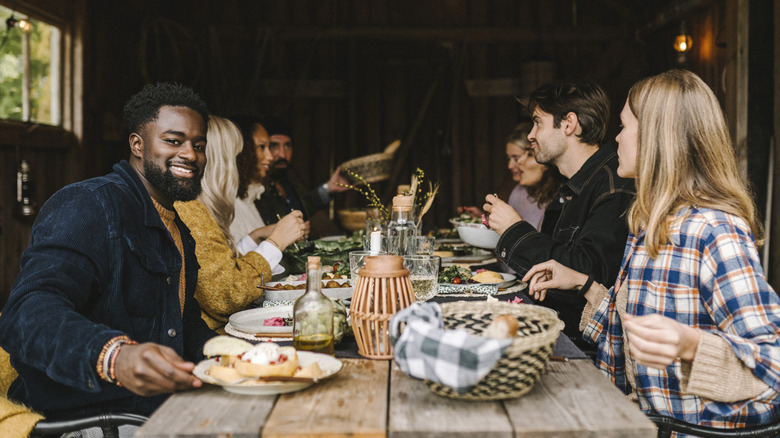The Dinner Table Rule You Can Ditch (& You'll Be Way More Comfortable)
When it comes to proper dinner etiquette, some rules stand the test of time. For example, one food-cutting rule remains firmly in place, while omitting your reason for using the restroom is another etiquette guideline to follow when excusing yourself at dinner. And while many of these rules exist for good reason, we wanted to find out if any had become outdated. To do so, Food Republic spoke with Jamila Musayeva, etiquette coach and author of "Etiquette: The Least You Need to Know."
Fortunately for casual diners, one rule is no longer as rigid as it once was: keeping your elbows off the table. "The rule against elbows on the table dates back to times when people ate communally on narrow tables. Elbows took up space and could disrupt others," Musayeva explained. While the reasoning behind the rule made sense in the past, today's wider tables and generally more spacious dining setups make it less relevant. However, it is still considered a bit of a faux pas in some settings. According to Musayeva, keeping your arms off the table helps maintain an elegant posture — especially important at formal dinners.
"At casual gatherings, it's less relevant, though resting an elbow while conversing is different from hunching over a meal," Musayeva said. "Today, in a casual setting when dining with friends and when the food is cleared away and only tea/coffee remains at the table, you may place your elbows at the table."
How to sit comfortably at a dinner table
As for how to sit at the dinner table in a way that is both comfortable and etiquette-conscious, Jamila Musayeva offered a few key pointers. "Sit with feet flat and back straight, letting hands rest lightly on the table when not using utensils. Forearms may rest near the edge without leaning in too much," she advised. This posture keeps you from looking stiff while still maintaining an open, engaged stance that encourages conversation.
You should also try to leave a bit of space between your back and the chair while keeping your feet uncrossed for extra balance and stability. While leaning on your elbows is acceptable at certain points during casual meals, if you need to rest a hand on the table, placing it lightly near your plate looks more polished than slouching forward on your elbows.
It's also worth noting that etiquette varies depending on where you are in the world. "Certain cultures have different etiquette when it comes to proper table position," Musayeva said. For instance, in the U.S., it is customary to keep your hands in your lap when not eating. However, if you're having a traditional meal in France, etiquette suggests keeping your hands on the table, with your wrists resting near the edge when not in use.


